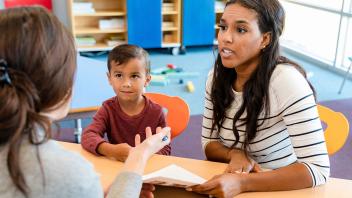So far, I have explained the literacy environment, print awareness, and sight word teaching that were part of teaching my daughters to read, but phonics also played an important role.
I have explained that my children were remembering words from their language experience stories. My teacher preparation students at the university asked me how many words my daughters would need to know before they could read; a very interesting question. In fact, there is no set number. Memorizing some words is always part of beginning reading, but reading is more than memorizing words.
Phonics both reduces students’ reliance on word memorization and makes such memorization easier. It accomplishes the former, by allowing students to sound out words that are yet unknown. Phonics allows the young reader to approximate the pronunciation of a word from nothing but the letters on the page, a liberating tool.
But phonics instruction also sets students off on trying to figure out and use the spelling patterns in text. Those patterns are not usually used to “sound out” words in any obvious way (except initially), but learning them does seem to increase how quickly and easily students come to “remember” words. Initially, children struggle to remember words, but as they learn the spelling patterns and sound-symbol relations the words get stickier — they seem to stay in memory with much less work.
Our girls received their systematic explicit decoding instruction from cheap workbooks purchased at the grocery store. These workbooks were neither thorough nor especially well constructed, but they gave my daughters practice auditory discrimination (hearing the phonemic contrasts) and sound-symbol correspondences.
We didn’t’ just assign pages to them to do independently, but usually we did these pages with them — these sessions ran for as little as a few minutes (when they weren’t interested) to several minutes at a time when they were engaged. Believe it or not, lots of kids enjoy workbook pages.
It is a kind of “playing school” that can be profitable.
I never set particular amounts of phonics to accomplish (such as three pages a day). But we worked on these several times a week and both girls were able to go through them pretty quickly.
Through these kinds of materials (including alphabet blocks and magnet letters on the refrigerator), they learned all the letters and sounds. E., with her special strengths in language, caught on pretty quickly and could do all the pages with minimal adult instruction; M. needed more explicit support to complete them, and the work went a bit slower. They both managed to learn all of the letter names (lower case and capitals), and all of the single consonant sounds and beginning consonant digraphs (sh, ch, th, wh) before they could really read. Just as reading is not the mastery of some number of words, it is also not the mastery of some number of sound-symbol relations.
By the time they knew their letters and sounds, the dictation work had started to disappear, replaced by their own writing. Both could do simple writing before they could actually read. They knew how to use the sounds to produce letters and could represent words they wanted to write. (I would make a big deal out of how wonderful this was and would print the words in standard spelling on the back).
At this point, they knew all the letters and many of the letter sounds, could recognize some words, understood how print worked (that the words told the story, the direction that print ran), and were surrounded with reading and writing in their environment. All of the raw materials of reading were in place, but what about reading?
In the next entry in this space, I’ll explain how they finally crossed the boundary and entered into the land of literacy.
See the three related posts here:

